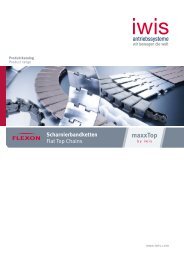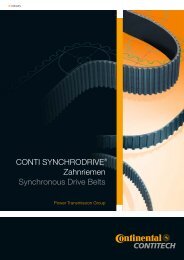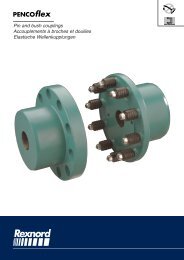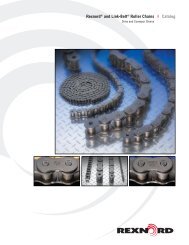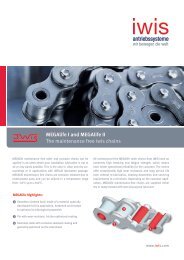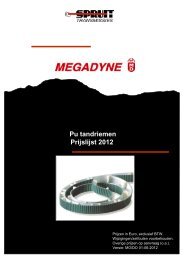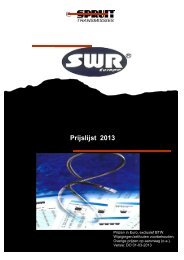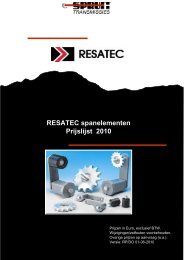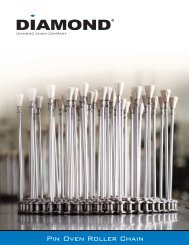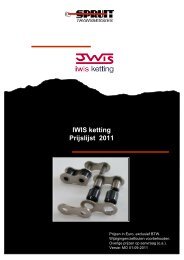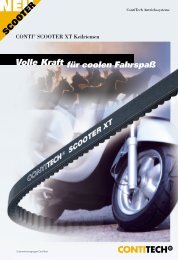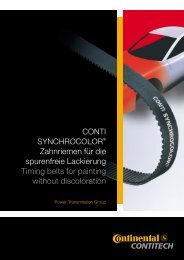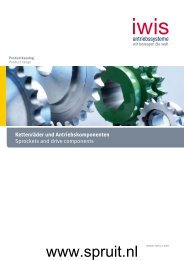und Förderketten High-performance roller and conveyor chains
und Förderketten High-performance roller and conveyor chains
und Förderketten High-performance roller and conveyor chains
Create successful ePaper yourself
Turn your PDF publications into a flip-book with our unique Google optimized e-Paper software.
iwis Customer Service<br />
CallBack Tel: +49 2739 86-0 Fax: -22<br />
E-Mail: sales-wilnsdorf@iwis.com<br />
3<br />
1<br />
2<br />
Rotary-Ketten<br />
Heavy-duty cranked-link transmission <strong>chains</strong><br />
Rotary-Ketten wurden vor allem für den Einsatz in besonders<br />
hoch beanspruchten Kettentrieben <strong>und</strong> für sehr ungünstige<br />
Betriebsbedingungen entwickelt. Diese Kettenart hat sich in<br />
den letz ten Jahren auf Gr<strong>und</strong> besonderer Widerst<strong>and</strong>sfähigkeit<br />
gegen sehr starke Stöße, großen Verschleiß <strong>und</strong> raueste<br />
Betriebsbedingungen ein weites Anwendungsgebiet erobert.<br />
Rotary Ketten sind weitestgehend maßlich nach ISO 3512, ANSI<br />
B 29.10 <strong>und</strong> DIN 8182 genormt.<br />
Ein bedeutender Vorteil der Rotary-Ketten ist, dass sie aus gleichartigen<br />
Gliedern bestehen <strong>und</strong> sich somit leicht verlängern oder<br />
verkürzen lassen. Zusätzlich haben Rotary-Ketten den Vorteil<br />
gegenüber St<strong>and</strong>ardrollenketten, dass alle Glieder gleichmäßig<br />
dem Verschleiß unterliegen.<br />
ELITE-Rotary-Ketten mit gekröpften Gliedern werden in versplinteter<br />
Ausführung 1 hergestellt. Je nach Beanspruchung werden<br />
die Laschen 2 aus naturhartem oder vergütetem Spezialstahl<br />
hergestellt. Für besonders hochbeanspruchte Ketten verwenden<br />
wir induktiv gehärtete Bolzen 3 , um höchste Zähigkeit bei größtmöglicher<br />
Oberflächenhärte zu erreichen.<br />
Anwendungsbranchen:<br />
• Erdmaschinen<br />
• Raupenfahrzeuge<br />
• Bohranlagen<br />
• … <strong>und</strong> viele mehr<br />
Rotary <strong>chains</strong> were developed primarily for chain drive applications<br />
involving extremely heavy loads or particularly adverse operating<br />
conditions. Chains of this type are particularly resistant to violent<br />
shocks, wear <strong>and</strong> extreme operating conditions, <strong>and</strong> have consequently<br />
enjoyed increasing success in a wide range of applications<br />
in recent years. For the most part, rotary chain dimensions are<br />
st<strong>and</strong>ardized <strong>und</strong>er ISO 3512, ANSI B 29.10 <strong>and</strong> DIN 8182.<br />
One significant advantage of rotary <strong>chains</strong> is that their links are all<br />
constructed to the same pattern, making it easier to lengthen or<br />
shorten the <strong>chains</strong> when required. They have another advantage<br />
over st<strong>and</strong>ard <strong>roller</strong> <strong>chains</strong> – all links are subject to the same level<br />
of wear.<br />
ELITE rotary <strong>chains</strong> with cranked links 1 are fitted with cotter pins.<br />
The chain plates 2 are available in naturally hardened steel or<br />
special tempered steel, according to the expected mechanical load.<br />
Chains subjected to extremely high loads are fitted with inductionhardened<br />
pins 3 , making them not only extremely tough, but also<br />
giving them the highest possible level of surface hardness.<br />
Industries <strong>and</strong> applications:<br />
• Excavators<br />
• Caterpillar track vehicles<br />
• Drilling rigs<br />
• … <strong>and</strong> much more besides<br />
8<br />
107



